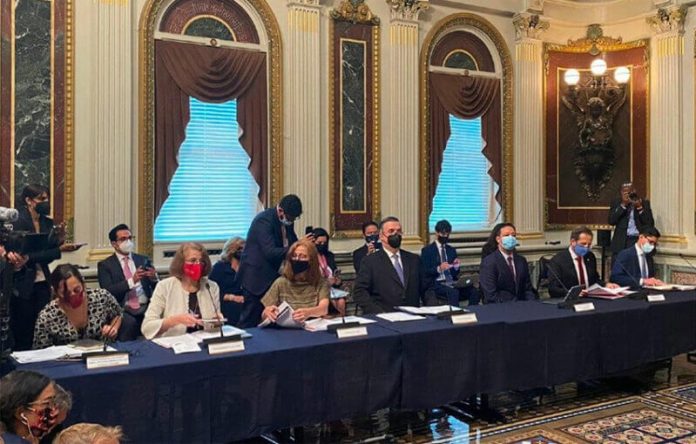The United States has agreed to collaborate with Mexico on employment programs in the southern region of the country and in Central America, the federal government said Thursday after high-level talks in Washington D.C.
In a statement outlining the four central pillars of a relaunched U.S.-Mexico High Level Economic Dialogue (HLED), the Ministry of Foreign Affairs (SRE) said the United States will provide technical support to attend to structural causes of migration in northern Central America.
It said the United States will collaborate with Mexico and Central America on the Sembrando Vida (Sowing Life) tree-planting employment program and the Youths Building the Future apprenticeship scheme.
President López Obrador has lobbied the U.S. government to support an expansion of the government programs to the nations of Guatemala, Honduras and El Salvador.
Cooperation on the programs falls under “Promoting Sustainable Economic and Social Development in Southern Mexico and Central America,” or Pillar II of the HLED, which was reactivated on Thursday after the forum’s suspension by former U.S. president Donald Trump.
Foreign Minister Marcelo Ebrard and Economy Minister Tatiana Clouthier led a Mexican delegation to meet with a U.S. contingent headed by Vice President Kamala Harris and Secretary of State Antony Blinken.
The White House said in a statement that the HLED will allow the United States and Mexico to rebuild and grow as dynamic partners as the two countries face new challenges.
With regard to Pillar II, the White House said the United States and Mexico “will identify complementary and cooperative opportunities to improve livelihoods through the creation of jobs and opportunities in the short, medium, and long term in El Salvador, Honduras, Guatemala, and southern Mexico, increasing its trade potential and spurring investment.”
It also said there will be increased technical cooperation between the U.S. and Mexican international development agencies.
The United States has seen a surge of migrants to its southern border since President Joe Biden took office in January, and his administration is determined to stem the flow while moving away from some of former president Donald Trump’s harshest migration policies.
The three other pillars of the relaunched HLED are Pillar I: Building Back Together; Pillar III: Securing the Tools for Future Prosperity; and Pillar IV: Investing in Our People.

Under Pillar I, Mexico and the United States will create a bilateral working group on supply chains to “identify areas of complementarity on new and existing chains in order to maintain their correct functioning in the face of possible disruptions,” the SRE said.
Clouthier told a press conference in Washington that Mexico raised the need to “sit down with industries or companies and be able to detail the components of semiconductors” in order to determine what parts would be manufactured in Mexico and what parts would be made in the United States.
The White House said the two countries will “build back together in an environment informed by the pandemic by improving the regional business environment and strengthening the resilience of U.S.-Mexico supply chains,” adding that “work under this pillar will include how to best facilitate economic recovery and strengthen infrastructure, trade facilitation, and innovation.”
In her opening remarks at the bilateral meeting, Vice President Harris said the coronavirus pandemic has undermined the global economy and that climate change and cyberattacks have posed risks to supply chains. The issues require a unified response from the United States and Mexico, she said.
Under Pillar III, bilateral cooperation will focus on mitigating cyber threats directed toward supply chains and improving the flow of data between the two countries, the SRE said.
Under Pillar IV, “the United States and Mexico will foster cooperation towards a more inclusive workforce that is better educated, more competitive, and better trained with the necessary skills to meet the needs of the 21st century economy,” the White House said.
The SRE said there will be a focus on providing skills training to vulnerable sectors of the population such as women, young people, indigenous people and members of the LGBTQ+ community.
Mexico and the United States also agreed that there is a need for greater bilateral cooperation on the issues of climate change and workers’ rights.
The United States’ so-called “Remain in Mexico” policy, which forces migrants to stay in Mexico as they await the outcome of their asylum claims in the U.S., was not discussed, Ebrard told a press conference.
A U.S. Supreme Court decision late last month obliged the Biden administration to reinstate the Trump-era policy formally known as the Migrant Protection Protocols, and Mexico had indicated that it would initiate talks on migration issues.
While “Remain in Mexico” wasn’t raised, Ebrard passed on a letter from López Obrador in which he lobbied the United States to offer more visas to Central American migrants. The president is proposing that migrants who participate in his administration’s employment schemes be given temporary visas to work in the United States, an idea the U.S. has not (yet) come to embrace.
Mexico did raise the issue of the pandemic-era border closure that has stopped nonessential travel from Mexico since early last year.
“Both Minister Clouthier and Ambassador [Esteban] Moctezuma raised [the subject],” Ebrard said. “[The reopening] was set out as a logical thing and it will be dealt with as soon as possible in order to boost the economic activity of both countries.”
The foreign minister described the bilateral talks as “a success,” asserting there was good will on both sides of the table. The two countries share a common vision, he declared.
U.S. State Department spokesman Ned Price said the HLED “drives improved job creation, global competitiveness and reductions in poverty and inequalities, and that is to the benefit of U.S. citizens and Mexican citizens alike.”
Antonio Garza, a former U.S. ambassador to Mexico, said the resumption of the high level dialogue was “a significant step in broadening the bilateral agenda.”
With reports from El Universal, Milenio and Reuters
